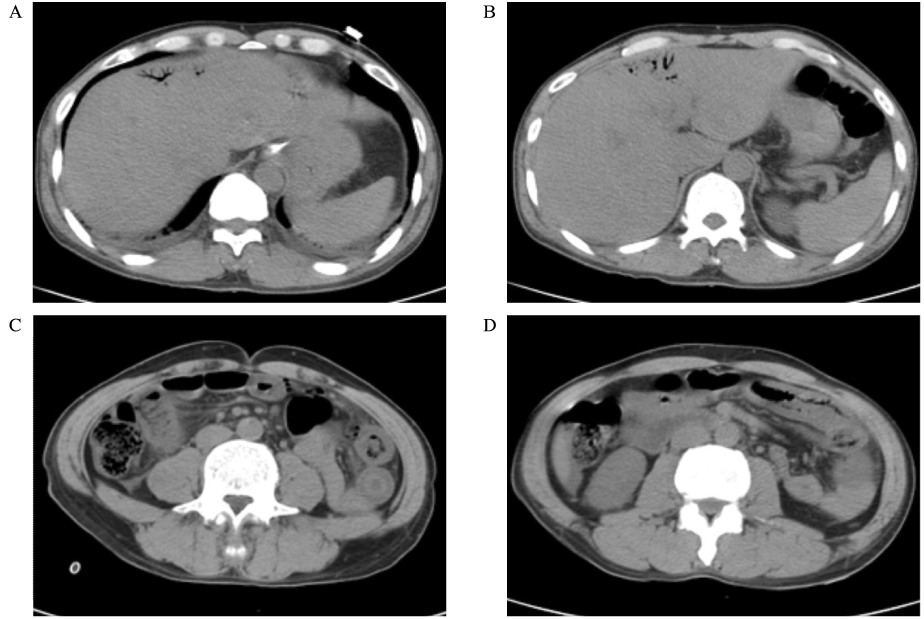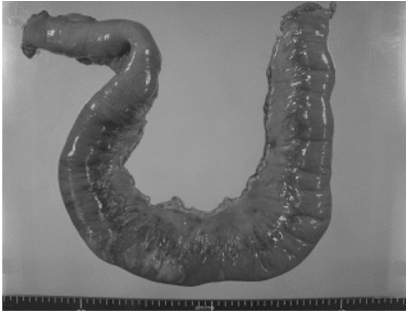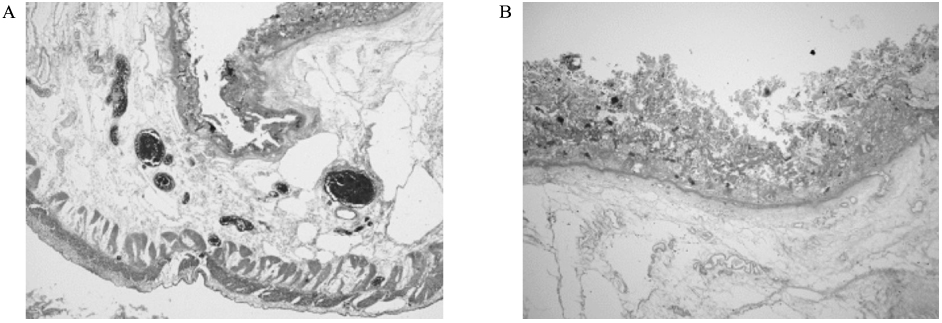J Korean Endocr Soc.
2009 Jun;24(2):116-120. 10.3803/jkes.2009.24.2.116.
A Case of Fulminant Type 1 Diabetes Mellitus Complicated with Ischemic Ileitis
- Affiliations
-
- 1Department of Internal Medicine, Korea University College of Medicine, Korea.
- KMID: 1468506
- DOI: http://doi.org/10.3803/jkes.2009.24.2.116
Abstract
- Fulminant type 1 diabetes is characterized by diabetes with an abrupt onset, severe metabolic acidosis at diagnosis, a low HbA1c level and negativity for islet cell-related autoantibodies, and this illness has been classified as type 1B diabetes by the WHO. The prevalence of this disease is higher in Japan than any other country and recently, there have been an increasing number of such case reports in Korea. Genetic factors and environmental factors such as virus infection and an immune mechanism have been suggested as the mechanism of the pathophysiology, but this remains to be clarified.
MeSH Terms
Figure
Reference
-
1. Alberti KG, Zimmet PZ. Definition, diagnosis and classification of diabetes mellitus and its complication. Part 1: diagnosis and classification of diabetes mellitus provisional report of a WHO consultation. Diabet Med. 1998. 15:539–553.2. Imagawa A, Hanafusa T, Miyagawa J, Matsuzawa Y. Osaka IDDM Study Group. A novel subtype of type 1 diabetes mellitus characterized by a rapid onset and an absence of diabetes-related antibodies. N Engl J Med. 2000. 342:301–307.3. Imagawa A, Hanafusa T, Uchigata Y, Kanatsuka A, Kawasaki E, Kobayashi T, Shimada A, Shimizu I, Toyoda T, Maruyama T, Makino H. Fulminant type 1 diabetes: a nationwide survey in Japan. Diabetes Care. 2003. 26:2345–2352.4. Jung TS, Chung SI, Kim MA, Kim SJ, Park MH, Kim DR, Kang MY, Hahm JR. A Korean patient with fulminant autoantibody-negative type 1 diabetes. Diabetes Care. 2004. 27:3023–3024.5. Imagawa A, Hanafusa T. Pathogenesis of fulminant type 1 diabetes. Rev Diabet Stud. 2006. 3:169–177.6. Lim CY, Kim HJ, Min KW, Kim HJ, Park KS, Kim EJ, Han KA. A case of fulminant type 1 diabetes with diabetic ketoacidosis and acute renal failure. Korean Clinical Diabetes J. 2006. 7:374–377.7. Kim DH, Jung JH, Lee KI, Cho YS, Kim TW, Rho DH, Kim NR, Park JS, Lee CH, Kim MK. A case of fulminant type 1 diabetes with pulmonary hypertension. J Korean Diabetes Assoc. 2007. 31:444–450.8. Yu HK, Nam M, Shim WS, Chung HJ, Kim EJ, Hong SB, Kim YS. A case of fulminant type 1 diabetes associated with pregnancy. J Korean Diabetes Assoc. 2007. 31:180–183.9. Nagaoka T, Terada M, Miyakoshi H. Insulin-dependent diabetes mellitus following acute pancreatitis caused by herpes simplex virus: a case report. J Japan Diab Soc. 2001. 44:335–340.10. Nishida W, Hasebe S, Kawamura R, Hashiramoto M, Onuma H, Osawa H, Makino H. A case of fulminant type 1 diabetes associated with high titer of coxsackie B3 virus antibody. J Japan Diabetes Soc. 2005. 48:suppl 1. A23–A27.11. Imagawa A, Hanafusa T, Makino H, Miyagawa JI, Juto P. High titres of IgA antibodies to enterovirus in fulminant type-1 diabetes. Diabetologia. 2005. 48:290–293.12. Shimada A, Maruyama T. Encephalomyocarditisvirus-induced diabetes model resembles "fulminant" type 1 diabetes in humans. Diabetologia. 2004. 47:1854–1855.13. Yamazaki M, Hayashi T. Rapid-onset type 1 diabetes mellitus without pancreatic exocrine dysfunction. Ann Intern Med. 2002. 137:145–146.14. Tanaka S, Kobayashi T, Momotsu T. A novel subtype of type 1 diabetes mellitus. N Engl J Med. 2000. 342:1835–1837.15. Shimada A, Morimoto J, Kodama K, Oikawa Y, Irie J, Nakagawa Y, Narumi S, Saruta T. T-cell-mediated autoimmunity may be involved in fulminant type 1 diabetes. Diabetes Care. 2002. 25:635–636.16. Endo T, Takizawa S, Tanaka S, Takahashi M, Fujii H, Kamisawa T, Kobayashi T. Amylase {alpha}-2A autoantibodies: Novel marker of autoimmune pancreatitis and fulminant type 1 diabetes. Diabetes. 2009. 58:732–737.17. Imagawa A, Hanafusa T, Uchigata Y, Kanatsuka A, Kawasaki E, Kobayashi T, Shimada A, Shimizu I, Maruyama T, Makino H. Different contribution of class II HLA in fulminant and typical autoimmune type 1 diabetes mellitus. Diabetologia. 2005. 48:294–300.18. Cho YM, Kim JT, Ko KS, Koo BK, Yang SW, Park MH, Lee HK, Park KS. Fulminant type 1 diabetes in Korea: high prevalence among patients with adult-onset type 1 diabetes. Diabetologia. 2007. 50:2276–2279.19. Jang E, Yi JE, Lee SJ, Chun SH, Baek KH, Song KH, Yoo SJ, Lee JM, Yoon KH, Kang MI, Lee KW, Kim MK. The classification of diabetic patients presenting diabetic ketoacidosis: The characteristics of fulminant type 1 diabetes. Korean Diabetes J. 2008. 32:428–434.
- Full Text Links
- Actions
-
Cited
- CITED
-
- Close
- Share
- Similar articles
-
- A Case of Fulminant Type 1 Diabetes in a Patient with Type 2 Diabetes Mellitus
- Malnutrition-Related Fulminant Type 1 Diabetes in a Patient with Sturge-Weber Syndrome
- A Case of Fulminant Type 1 Diabetes during Pregnancy
- A case of fulminant type 1 diabetes mellitus
- A Case of Fulminant Type 1 Diabetes Mellitus in an Elderly Patient




